Invisible "Opportunities" in the study of Mars

On June 10 and July 8, 2003, two identical vehicles set off to meet Mars on the top of two identical Delta-2 missiles, the fate of which turned out to be completely different: the connection with one of them was lost on March 22, 2010, while the other continues to work and to this day, having spent 5,000 earth days on Mars and 4,900 Martian ( solo ) days, in spite of the many dust storms and attempts to close the project. On September 28, 2004, asteroids with the numbers 39382 and 37452, respectively, were named after the merit of the red planet exploration of these vehicles (which was done for the first time among the landing missions).
For those who have not guessed who will be discussed today, this is the Opportunity rover who has traveled 45 km and exceeded his research plan 53 times. As well as his less fortunate fellow "Spirit" (surpassed the plan only 25 times).
Device design
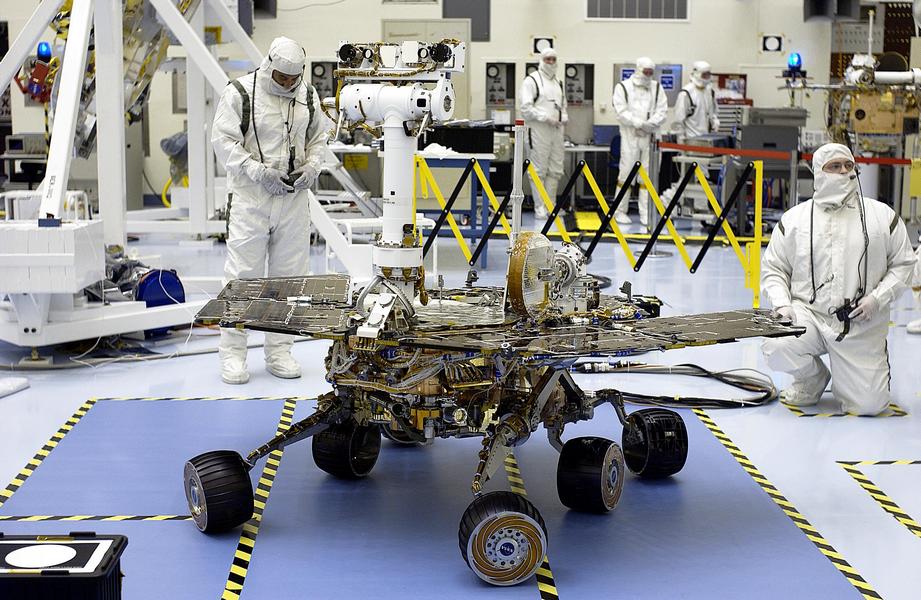
Both vehicles have a mass of 185 kg with a height of 1.5 m, a width of 2.3 m and a length of 1.6 m. It is driven by motors located on each of its 6-wheel platform with two rocker arms (these were used on all 3 generations of American rovers). This provides him with movement on slopes up to 30 ° and speed of movement up to 180 m / h (but most of the time he moves even slower).
The entire upper part of the rover is covered with solar panels of three-layer gallium arsenide (used on Deep space 1 and first flown to Mars). In addition to them, the rover has two more wings of solar panels, which during the flight were folded in half and laid above the main batteries (to fit in a pyramid-shaped transport container). At the beginning of the path of "Spirit" and "Opportunity" solar batteries produced up to 900 Wh / h for the salt, but during the Martian winter this value drops just below 300 Wh / h for the salt (which is not fatal for the apparatus, but severely limits their ability to movement and research).
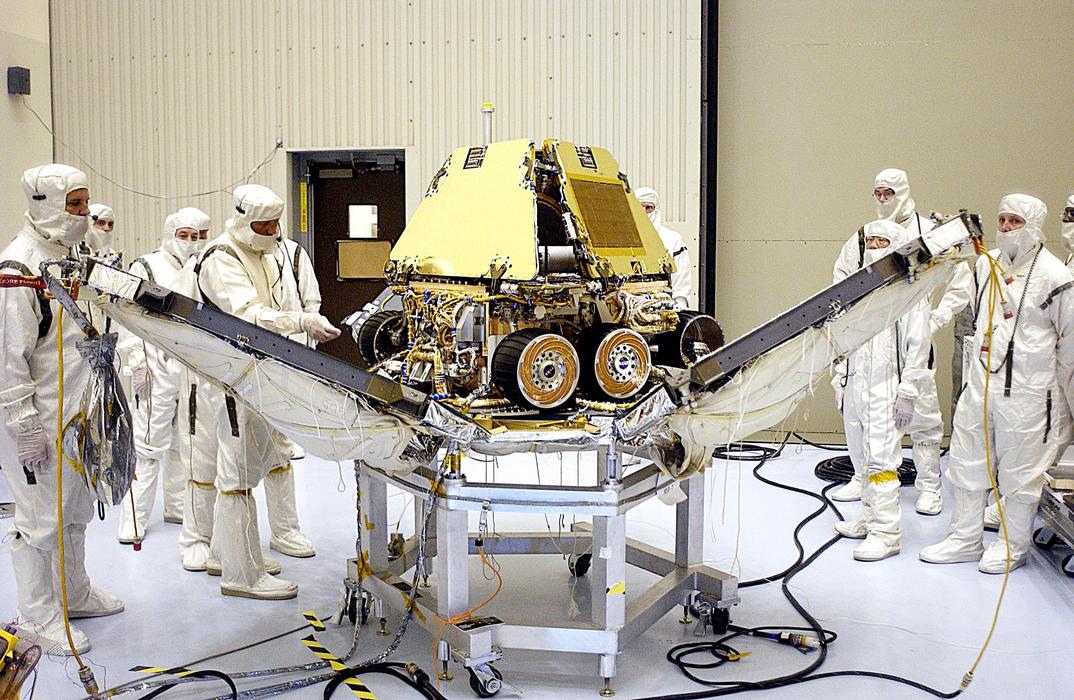
The threefold difference in illumination on Mars is associated with its more elongated orbit, which makes seasonal climate changes on Mars much more pronounced than on Earth (and in the southern hemisphere is noticeably colder than in the northern). Famous dust storms are also superimposed on these changes, by means of which carbon dioxide from one polar cap roams to the other (razmer on the summer side and freezing on the winter side).

To power the rover at night, lithium-ion batteries with a capacity of 8 ampere-hours are used to power the electronics heaters, which along with the isotope heat source maintain its operating temperature in the range of ± 40 ° (since the temperature on the surface of Mars can reach -127 ° C) , and feed his watch (so that he does not lose direction to Earth for his sharply directed antenna).
The device has 9 scientific instruments installed, the first three of which are placed on the rod towering above the rover: 1) two panoramic cameras ( Pancam ) for recording the texture, color, mineralogy and structure of the surrounding surface; 2) navigation monochrome cameras (Navcam) with a large viewing angle but lower resolution; 3) a miniature thermionic spectrometer ( Mini-TES ) which can examine the composition of a material at a distance according to its coefficient of reflection of infrared light; 4) the apparatus also contains two pairs of black-and-white cameras (Hazcams) with an overview of 120 ° in front and behind the apparatus (also for navigation purposes).
The mechanical arm of the device contains: 5) a Mössbauer spectrometer (MIMOS II or MB ) used to study iron-containing rocks and soils; 6) X-ray spectrometer ( APXS ) which determines the content of chemical elements in the soil; 7) a magnet for collecting magnetized dust particles; 8) camera-microscope ( MI ) for close examination of stones and soil; 9) an abrasive tool ( RAT ) for removing dust from the surface of the samples and producing small cavities several mm deep. The protective casing of the RAT device is made of aluminum obtained from the remnants of the twin towers .
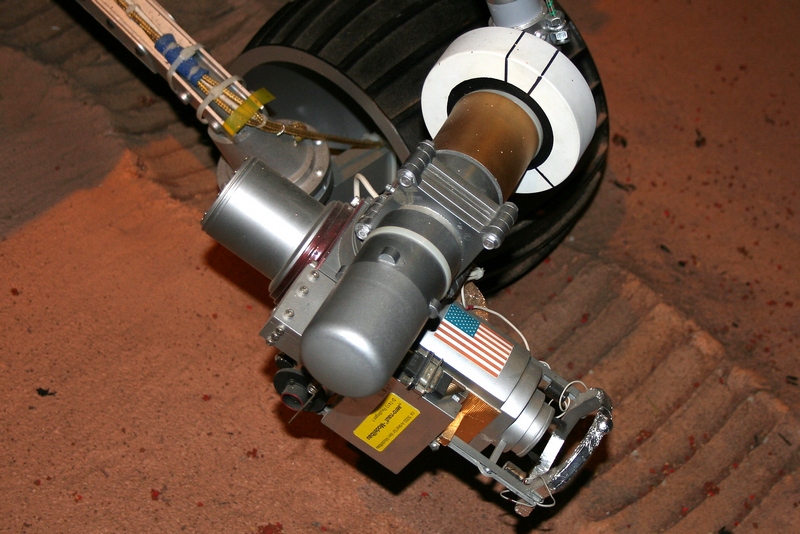
In addition, the Spirits landing platform was declared the “ Columbia Memorial Station”, and the Opportunity Platform was declared the “ Challenger Memorial Station”. On both platforms were placed two quartz DVDs containing 4 million names each, from the Planetary Society (the picture was taken by Opportunity for its 2 sojars on Mars using three filters):
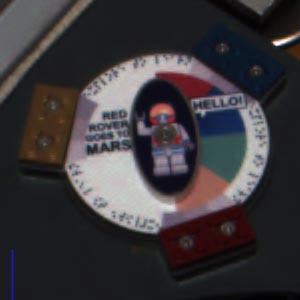
A special ICER compression algorithm was developed for storing and transmitting images from Spirit and Opportunity, which was designed for lossless image compression, which uses only integer arithmetic (since radiation-resistant processors usually do not have mathematical coprocessors that accelerate operations with floating point).
The path to Mars and the "first steps"
Having started on June 10 and July 8, 2003, they landed on Mars on January 4 and 25, 2004. For the delivery of vehicles to Mars, a flight module specially designed for them was used, which included: a flight level weighing 193 kg with 50 kg of fuel, a heat shield weighing 78 kg, a parachute system for 209 kg, a landing platform of 348 kg. Thus, the 183-kilogram rover was only a small part of the original platform in 1063 kg.
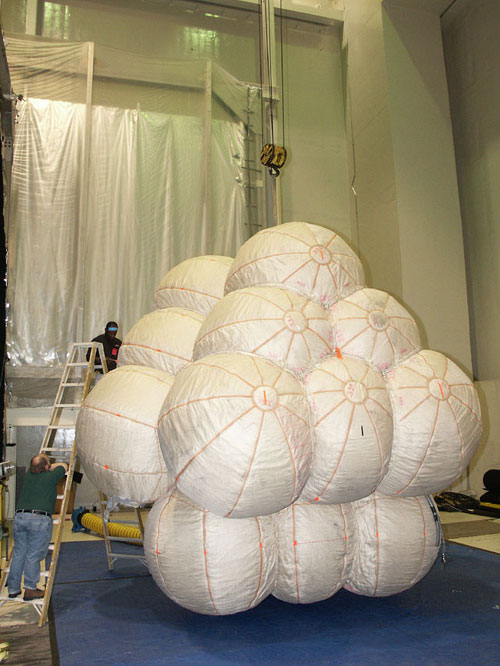
After braking with an ablation shield, the parachute opened and then with the help of three gas generators, air bags of vectran (which is almost twice as strong as Kevlar) were inflated . Immediately before contact with the surface of Mars, three rockets worked and extinguished the speed of descent, after which the platform separated from the parachute and gently landed on inflatable bags (5.5 m in diameter when opened). After the platform stopped rolling and opened, the rover straightened its solar panels, raised the camera bar and took the first pictures (to make sure everything was in order), and then went on to wait for receiving commands.
"Spirit" was sent to the crater Gusev where supposedly there was water in the early periods of the development of Mars, and Opportunity sat on the plateau of Meridian , where too there should have been water before. Both rovers were parachuting, which limited the landing accuracy to a 12x80 km zone. And although it was already many times better than the 100x200 km of “Sojourner” , but still not enough to get over 90 soloes of the main mission to a specific goal with such a deviation. Therefore, the joy of the team knew no bounds when it turned out that Opportunity sat right in a 22-meter crater (later called the “Eagle” ). This meant that the edges of the crater protected it from direct sunlight and made it possible to keep the water at its bottom longer (which means it increased the chances of finding traces of liquid water on the surface of Mars), and Opportunity almost immediately found strange balls called “blueberries”, which close examination turned out to be hematite :
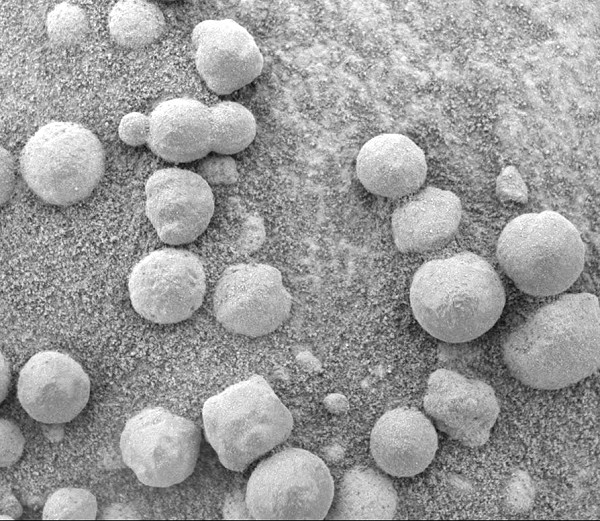
Spirit’s arrival earlier was not so successful: he also found the Sleepy Hollow crater about 9 by 12 meters, but due to a software error that caused the flash file system to overflow its flash memory (until February 3 ) in the process of restoring its performance. Fortunately, he was able to put his abrasive tool into use at 32 sol and make a 2.65 mm well (to even better than expected) and analyze its matter with a microscope and two spectrometers. On March 5, at a press conference, NASA reported that the device found a stone much like a volcanic rock through which small streams of water flowed. And the rover itself at this time was on its 370-meter journey to the Bonneville multiple , which it reached at 65 sol (11 March).

Opportunity for the first time launched its 30-sol abrasive tool to study the outcrop of El Capitan rocks. Traces of erosion were found on the rocks exposed by an abrasive instrument, and the Mössbauer spectrometer indicated the presence of jarosite in the rocks, and a miniature thermionic spectrometer — the presence of sulfates. In addition, it was decided to fix the 5 wheels of the rover to slip the remaining wheel for 22 minutes to get a trench 50 cm long and 10 cm deep in the soft soil of Mars. At the edges of the trench, pebbles and fine soil were found, the particles of which were not recorded even by the apparatus’s microscope. Thus, evidence of the presence of liquid water on the surface of Mars in the past was all added and added, and besides, there were equally good news - it turned out that the power supplied by solar panels was degrading much slower than expected, so that the mission of the devices was extended indefinitely.
“Spiritus” at that time was not lucky again: having reached Bonneville Crater, it was found that its edges are quite steep, and inside it there was nothing so interesting that it would be worth risking leaving the rover there forever, so he went on to the Missoula crater, which reached sol 105 (already abroad the main mission). This crater, however, also did not provide interesting material for the study, and "Spirit" skirting the sand dunes headed further to the "Columbia Hills", which were named after the astronauts who died during the crash of the same-name Shuttle:

On the Opportuny's approach to the cradle of Endurance on June 4, NASA announced that the rover will enter the crater even if it is known that it will not be able to get out of it:
"This is an important and balanced decision for the expanded mission of the rover," said Edward Weiler, NASA Deputy Director for Science.Fortunately, the edges of the crater were within the limits of the rover on the slope and justification was not required, since Opportunity could easily get out of the crater to its 315 sol (December 14). For this half of the Earth year, the rover found on the slopes of a 120-meter crater a layered structure similar to sedimentary rocks on Earth, as well as traces of water impact on the stones at the bottom of the crater, before and after its formation.
“The answer to the question of what happened before the evaporation of rocks in this area is the most important scientific task we can put on Opportunity at the moment,” said Steve Squires, lead mission researcher at Cornell University.

Panorama of the crater "Endurance" (original 28 MB).
By 159 salt “Spirit” reached the hills of Colombia and 23 sol studied its western slope, where he was finally lucky and he discovered a stone called “Pot of gold” , during the study of which Spirit was first discovered by hematite spectrometer Mössbauer.

Next, the rover began to move northward along the slope of the Hasband Hill, studying several stones in the course of its movement. From 239 to 262 “Spirit” was put into sleep mode, because the connection (the situation when the Sun is on the line between the Earth and Mars) blocked the connection of the Earth with it and with the satellites in the Martian orbit. After that, he continued to climb the hill and, at 344 sol, also made a test connection with the European satellite Mars-express . So ended for devices 2004 (Earth) year.
"Opportunity" at this time went to his ablative shield, which was dropped in the process of descent to the surface of Mars. Close to him, he stumbled upon a nickel-iron meteorite which became the first meteorite found on another planet (and the third one found beyond the Earth after two meteorites found by Apollo-12 and -15 on the Moon). They didn’t think of anything for him, and just called it “the heat shield stone” :
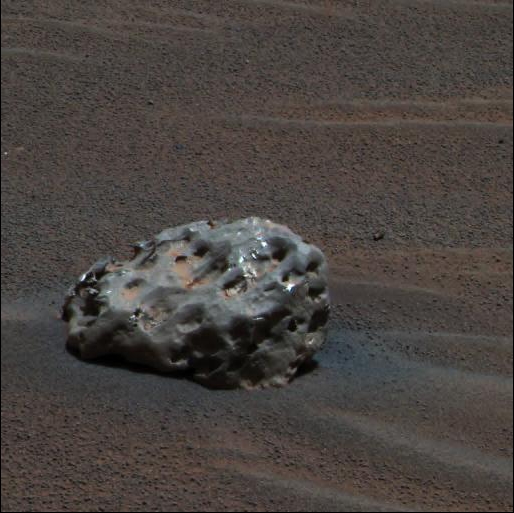
After that, the rover got to the Argo crater (at 365 salt) and the next day thereafter made a trench with its wheel to examine the ground under it. After a brief study of a pair of craters, he stopped at 392 salt to study the stone called “Normandy” for three solos and, having no interesting goals, accelerated near: on March 20, 2005, he set a record in travel speed for both rovers, breaking as much as 220 meters in a day. From 415 to 421 salt, Opportunity conducted a study of the differences in the properties of the recesses and ridges of the sandy ripples it had discovered.
At 446 salt, Opportunity, having overestimated its strength, dug up more than half of all 4 with its corner wheels on the slope of a 30-centimeter sand dune. Before attempting to do anything, it was decided to simulate this situation with a copy of the rover remaining on Earth (after this incident, a software update was also installed on the rovers to block the movement when a slip was detected). At 461 sol, he made the first test move, but only to 483 salt could finally get out. From 498 to 510 Sol, he studied this dune (called “Purgatory”) from a distance, after which he went to Erebus crater. The study of this 350-meter crater took Opportunity from 550 to 750 sola (from October 2005 to March 2006).
"Opportunity" a couple of times (at 631 and 658 sol) got into dust storms that cleaned its batteries of dust accumulated on it, and between them it was discovered that the motor with which the rover manipulator was placed in the stowed position began to act up. After two weeks of searching, it was decided to completely abandon the use of the traveling position of the manipulator in order to prevent a possible jamming of the manipulator in the non-working position. Problems with the Opportunity manipulators began almost from the second sol on Mars, when it turned out that the heater of the hinge nearest to the rover was blocked in the on position. Before the first winter on Mars, the manipulator was saved by the overheating protection system that automatically turned off the heater, but during the first winter (when most of the equipment was turned off forcibly, to save a small amount of battery energy) - the manipulator’s electric motor was still damaged due to temperature drops, so that it became necessary to give him more current than usual, but at the same time he still sometimes began to jam.
"Spirit" at this time was able to capture his atmospheric assistants ( sand devils ) who periodically cleaned the dust from both rovers. This unexpected meeting at once raised the performance of solar cells by 1.5 times (up to 93% of the initial capacity).

Pictures taken by "Spirit" with an interval of about 30 seconds, which captured the "dust devil" moving at a speed of about 17 km / h. On 618 sol (September 29, 2005) "Spirit" reached the top of the hill of Hasband and made another panorama from it:

At 778 sol (March 13, 2006) the right front wheel refused from Spiritus, because of which he had to climb the slopes to his next goal (McCool Hill) backwards. As a result, it was decided to abandon the rise on this hill at all in favor of Low Ridge Haven, where he had to spend as many as 9 months immobile since April 9, 2006, since the Martian winter meant an excessively low level of solar cell performance, which was barely enough for heating and power hours, as well as a periodic connection with the Earth.
At 766 sol (March 22, 2006), Opportunity observed the passage of Phobos before the Sun, after which he set off on a journey to Victoria Crater, which he had reached a 951 sol (by September 26).

Farewell look at the crater of Victoria before departure.
On January 4, 2007, an update was installed on both rovers to automate the transfer of important images and the movement of the manipulator to examine the stones. At the same time, both rovers had the opportunity to determine the argon content in the atmosphere of Mars, thanks to which the rovers could study its concentration on opposite sides of Mars at the same time. Back in January, Opportunity discovered the second meteorite called Santa Caterina, after which he finally reached Victoria Crater, but at the location chosen for entry, the slope was too steep for the rover and he had to go back in search of a better place to descend . In the meantime, “Spirit” unexpectedly made a discovery for everyone (in March 2007), when dragging its wounded wheel, it opened the soil rich in silicates under the thin layer of Martian dust (which was supposed to be ideal for microbial life forms).

In the end, by July 18, Opportunity was able to find a suitable place to descend, but the global dust storm on Mars that started at that moment forced us to cancel all plans and worry about the continuation of the mission: the dust suspension in the atmosphere rose to such a level in a couple of weeks that began to block 99% of the sunlight reaching the surface and both rovers gradually began to lose their batteries.
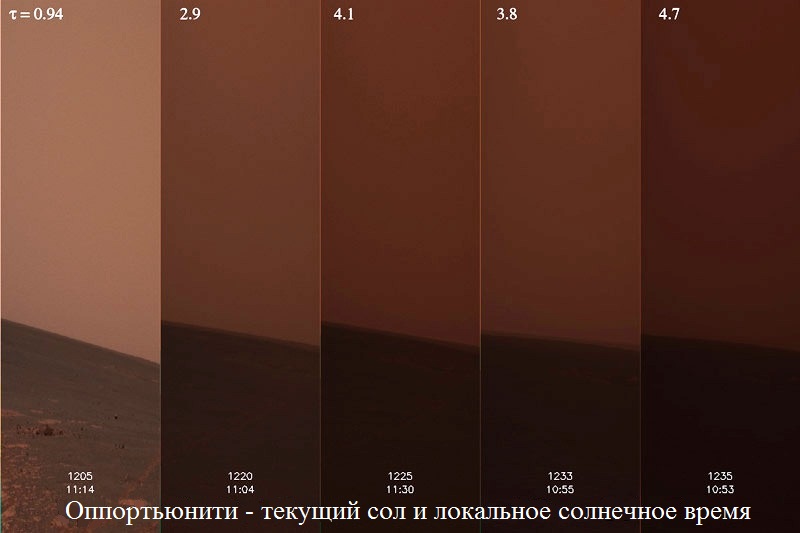
NASA issued a statement to the press that "we are worried that our rovers would survive the storm, but they were not designed for such difficult conditions." Opportunity was in much better condition, since several atmospheric disturbances shortly before this storm (by 1163 sol) brought the performance of its solar cells to a level that was not from 16 sol. But the "Spirit" was parked on a cleavage with the highest possible slope (to reduce dust and increase the performance of solar panels). But it was not enough to clear this with the solar panels, and the struggle for the rover continued throughout 2008 (so for the entire year, "Spirit" managed to make only one panorama ). During the tests, it was established that the thermionic spectrometer must survive cooling and subsequent heating, as a result of which its heater was turned off, which saved the Mars Rover 29 Wh / hr per minute.
"Opportunity" returned to work on 1255 Sol (August 7, 2007), starting with the transfer of images. As it turned out, the storm did not pass for the rover in vain - its miniature thermionic spectrometer was clogged with dust and could no longer work. By 1269 Sol, he set about to move and, at 1290 Sol (September 11), began a cautious descent into the crater of Victoria. In studying this rather big (750 m in diameter) crater, the rover spent a whole Martian year - up to its 1634 sol on Mars and August 2008 earth time.

Panorama of the crater Victoria (original 9 MB)
At 1502 Sol (April 15, 2008), the rover manipulator jammed again, and 27 days passed in an attempt to revive it. Ultimately, the rover operators managed to pick up the time when the temperature of the manipulator rose above everything (in the morning at 8.30 local time Martian time) and they were able to get it to work by applying the maximum power to its heater. After that, for Opportunity, a driving technique with a manipulator unfolded into working condition was developed, and the rover itself, due to the lack of targets in the nearest visibility, was decided to be sent to the crater Endeavor , 12 km away, so following its movement along the Meridian Plateau Opportunity spent two whole years. In 1947, Sol (July 18, 2009) Opportunity noticed a dark stone, which he went to consider - he was already the third meteorite on his way, which he explored until 2004 Sol (September 12). The meteorite was called “Blocking Island” . But already in 2022, another 0.5-meter meteorite was discovered called the “Island of Shelter” . This time it was enough for research for 12 days, and the rover returned to its journey again.
At 1797, Sol (January 22, 2009) "Spirit" started moving again, the performance of solar cells began to rise to 372 Wh (by the year 1864) Sol (March 31) and it seemed that everything had begun to improve. But already on May 1, the device was stuck in a soft yarosite (having a low coefficient of friction) which was hidden under a seemingly completely passable surface. At the same time, the front right wheel became functional again, but almost immediately it failed again, and by 2097, salt (November 28), the rear right wheel also failed. In the course of multiple attempts to free up the rover, time passed until 2155 sol (January 26, 2010), when, losing all hope, NASA decided to stop unsuccessful attempts to pull out the rover and rename the mission of the mobile robot to a stationary research platform.

Panorama of the final stop "Spirit"
However, this could not help to agree with entropy, so that the further fate of "Spirit" was predetermined - without the ability to move, the solar batteries of the rover could not be sufficiently cleaned, so that the energy produced by them was simply not enough to survive the winter. The final report of the rover received on March 22, 2010 (for 2210 sol) contained data on the performance of solar batteries at 134 Wh / h per salt and the temperature of the electronics unit at -41.5 ° C. In the course of attempts to resume communication with "Spirit", 1300 teams were transferred to him until May 24, 2011, but they did not lead to success. In total, the rover traveled 7,730.5 m.
Thus, until August 6, 2012, Opportunity was in the role of Mark Watney, alone on a whole planet, before landing on Mars. But the rover was not going to surrender: on 2138 salt (January 28, 2010), he explored the small 10-meter crater of Concepcion and, going around the dangerous section of the road to 2231 salt, went to the crater of Santa Maria on its way to its main goal. To his 2246 sol (May 19, 2010), he broke the Viking-1 record, becoming the most long-term mission on the surface of Mars. At 2449 Sol (December 15, 2010) he reached the 90-meter crater of Santa Maria, but after taking only a few pictures from its edge, he stopped at the parking lot (since in January 2011, another connection of Mars and the Sun was to occur, meaning a loss of communication for a few weeks). After the connection was resumed, the rover again continued its journey and reached its first goal in 2709 Sol (August 9, 2011) in the Endeavor crater, called the “Spirit Point” (in honor of the silent rover mate), having already covered 21 km since leaving Victoria Crater:
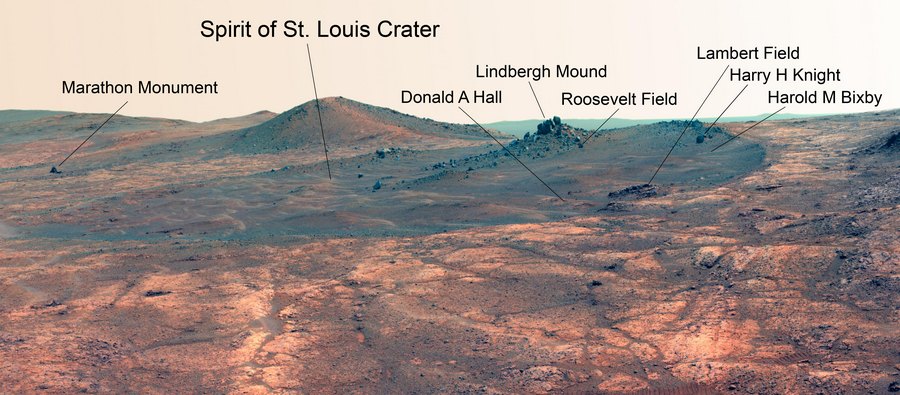
Another 2692 salt on the approaches to the crater was discovered a new breed which was not previously registered by the rovers. Steve Squires described this discovery as follows:
This structure is similar to some volcanic stones, but contains more bromine and zinc than typical rocks. «».Although two devices of the rover were out of order - a miniature thermionic spectrometer and a Mössbauer spectrometer (from clogging with Martian dust and drying out of a radioactive source) - but the microscope, X-ray spectrometer and panoramic chambers of the rover allowed us to judge that he was able to detect the gypsum : the rocks found hydrated sulfate calcium sulfate gypsum and minerals that could not form without the presence of water. On 2783 Sol (11 November), the rover drove down a 15 ° slope to increase the performance of solar cells in preparation for the fifth Martian winter.
At 2,947 sol (May 8, 2012), Opportunity's solar energy production increased enough so that he could start moving again. On August 6, 2012, the rover sent a signal to Earthdecimeter range so that the Canberra Far-Field Communication Complex could check the equipment’s readiness for arriving on Mars “Curiosity” (Curiosity), and on 19 August the Mars Express greeted both rovers simultaneously, checking the communication channels. After that, Opportunity went on and visiting the craters of Berrio and San Rafael, moved to the Matievich Hill for the study of which he spent the time from October 2012 to May 2013. Panorama of Matievich Hill in close to natural colors (original 5.8 MB)
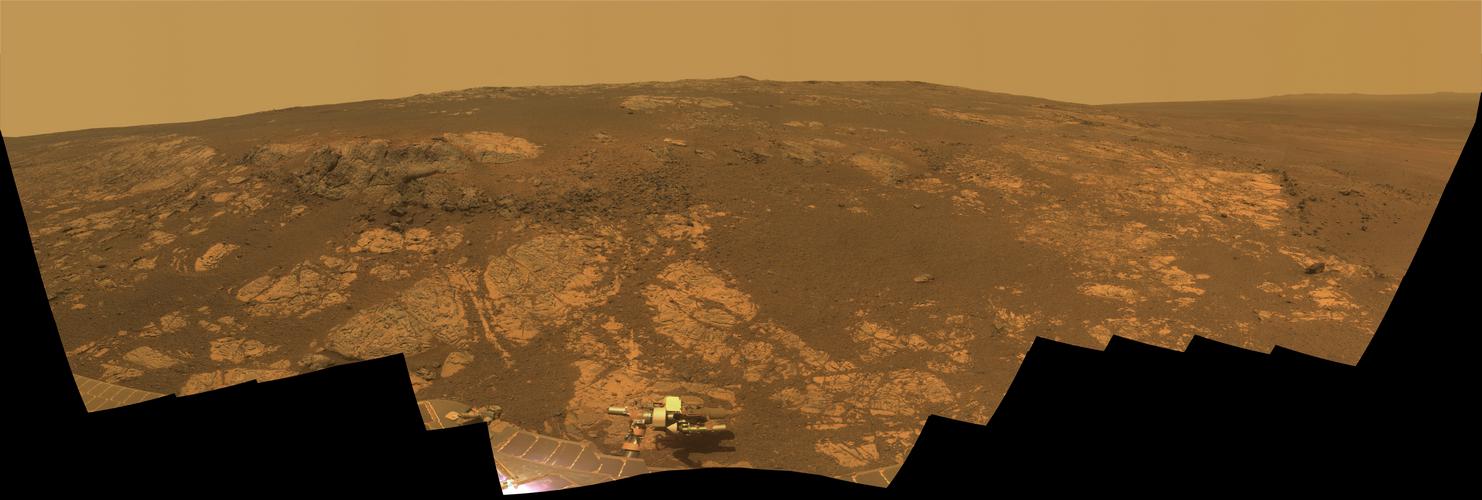
This time Opportunity spent exploring the “new berries” (called so in contrast to the old berries - strange balls that were found at the site of its planting in early 2004), stones and a geological map of the area. On May 16, 2013, NASA announced that Opportunity had covered the greatest distance from their vehicles (having traveled 35,744 km by that time. The Esperance mountain formation studied on May 17 showed that water on the surface of Mars in the past could have a neutral pH . On June 21, it began the sixth year of Opportuny’s presence on Mars, and the rover was heading for a hill called Solander at a speed of 10 to more than 100 meters per salt. In September 2013, he reached its foot and began to study its foot, then proceeded to a leisurely climbing this 40 meter hill.
On January 8, 2014, a 4-centimeter Pinaccle Island stone was found which was not in the previous pictures of the rover. During the trial, it was established that he was dug out "Opportunity" from the soil during the slip in early January. The stone itself contained magnesium, manganese and sulfur, and since these materials were water soluble, NASA suggested that they could be concentrated in one place by water. On July 28, the rover walked around Lunokhod-2 along the total distance covered, becoming the vehicle that traveled the most outside the Earth. Despite the problems with flash memory (which were located in one of 7 flash memory cells and subsequently turned it off), in late August / early September, Opportunity overcame a marathon distance, heading already to the Ulysses crater:

The place between the two hills into which he was heading was called the “Marathon Valley”, and the rover itself had to overcome further difficulties: the slopes of the Endeavor crater were very steep and Opportunity had to climb 32 ° down the slope trying to get to Knudsen ridge which the scientists wanted to explore, but later three attempts mars rover had to retreat all the same. Driving along the slope of the crater Endeavor, the rover headed in mid-2015 to the valley between its slopes, which supposedly could have formed in the process of erosion.
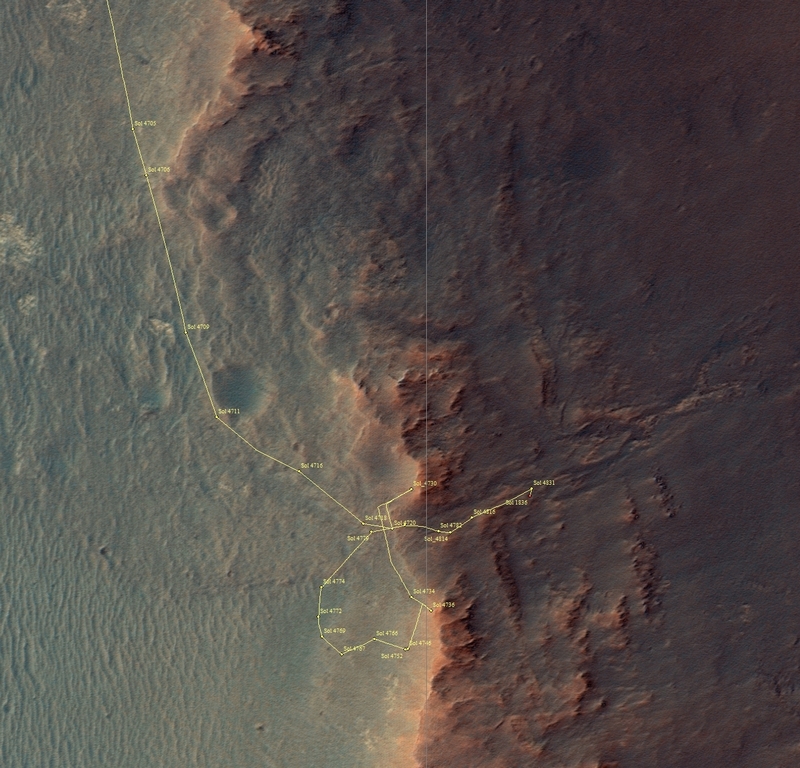
In 2017, Opportunity survived the next Martian winter and continues to explore the valley with all the tools available to it, and also measures the argon content in the atmosphere of Mars (now only one). At the end of August, he overcame the bar already in 45 km overcome by him on Mars and is not going to dwell on it.
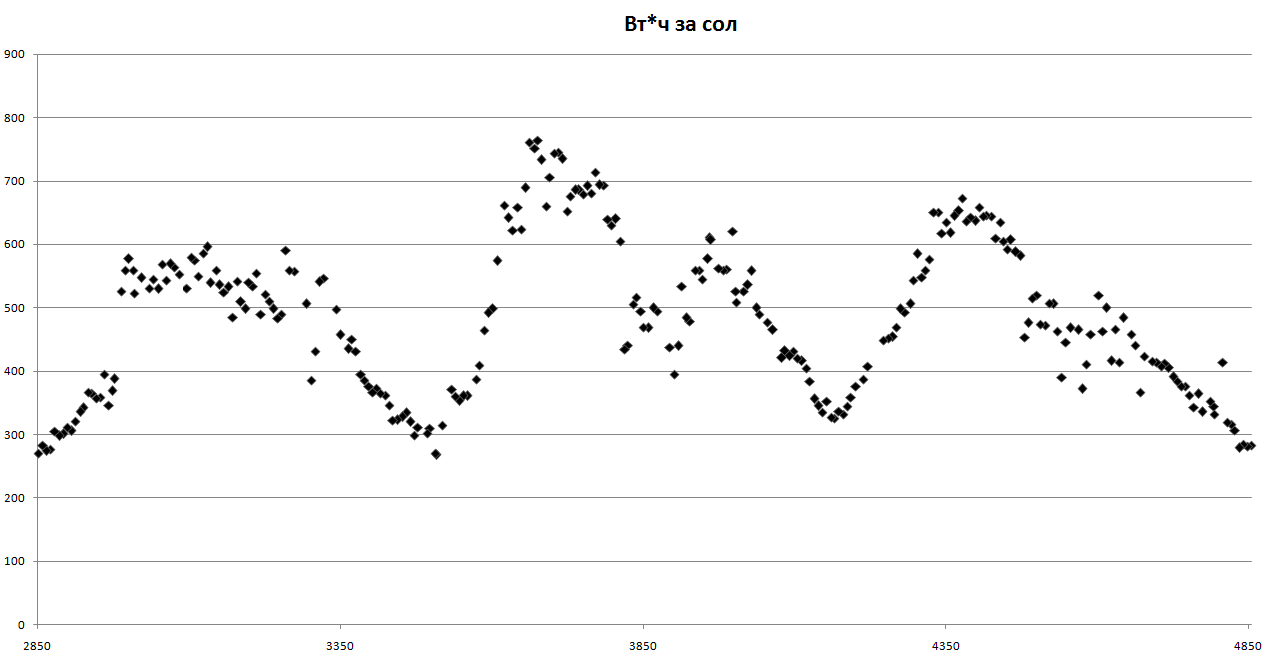
The performance of solar cells over the past three Martian years. As can be seen on the graph, the performance of the salt changes during the Martian seasons, but the efficiency of the batteries practically does not degrade and does not threaten the existence of Opportunity. The main reason for choosing the RTG for “Curiositi” is its large mass and therefore the large power required, which would require solar cells over many m 2 of area, which would significantly restrict its mobility.
Congratulation "Opportunity" on the 13th anniversary:
Curiosity News
And now the news from the other end of Mars (from the Gale crater ): the data obtained from the instruments of the MAVEN satellite and the Curyositi rover during a large solar flare ( class X8.2) reached Mars, allowed to estimate the dose that the astronauts on the surface could get and how well the atmosphere of Mars protects from such an impact. Particles of lesser energy (green line) - an astronaut on the surface is not fully recorded, and an astronaut on the surface without any protection would receive 0.43 and 0.34 Gray of radiation on September 11 and 12, respectively (the minimum dose for the manifestation of signs of radiation sickness is 1 Gray, lethal dose is in the range of 6-10 Gray).

Thus, this flash is at the border of the safe limit (for a base without protection). But firstly - although in the history of observations there were flashes and more powerful , but nevertheless it was the third flash of power over the past 11 years (the complete cycle of the Sun), and secondly, this problem is solved by the presence of a bulk protection from the Martian base (about which NASA is already thinking about ) and flying in a ship with a solar shelter (where you can wait out these couple days of turbulent space weather).
References:
→ Weekly reports on the status of Opportunity
→ Video recording of the Opportunity Martian marathon
→ Maps of its movement
→ Interactive maps of Mars on NASA and JPL
→ Well, I think that these two pictures about Spirit should be here: 1 , 2 .
All Articles